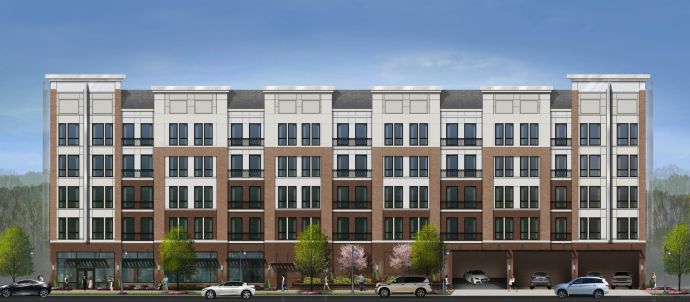Mineola’s fourth large, transit-oriented apartment complex has won tax breaks from the Nassau County Industrial Development Agency, setting the stage for construction to start.
The agency’s Board of Directors on Tuesday approved $2.24 million in sales and mortgage-recording tax exemptions and a 20-year property tax deal for Mill Creek Residential Trust’s $70 million, 192-unit development at the former site of the Corpus Christi Elementary School.
The deal allows the Texas-based company to close the $6.7 million purchase of the land on Searing Avenue, which will allow the Corpus Christi parish to pay off its $400,000 debt to the Roman Catholic Diocese of Rockville Centre.
“It’s a real good win for everybody — a win for the community of Mineola and a win for Corpus Christi,” said the Rev. Malcolm Burns, Corpus Christi’s pastor.
The church is financially stable now, but many young families left when it closed the school in 2010, Burns said.
The IDA agreement puts the Catholic parish’s land back on the tax rolls. Local municipalities will get more than $10.8 million in tax revenue over 20 years from Mill Creek’s fixed payments in lieu of property taxes, said Joseph Kearney, the agency’s executive director.
It is uncertain how much the deal saves Mill Creek in property taxes. IDA officials have said that is because property values fluctuate and the tax discount would change each year.
The project is expected to have a total economic impact of $98 million over 20 years and create six permanent full-time jobs and 290 construction jobs, Kearney said.
Mill Creek will also pay $1.7 million to the Village of Mineola and rent 19 of the apartments at affordable rates as conditions of the village’s approval.
Mill Creek also built the 275-unit Modera Mineola, which opened last year, and a 36-unit affordable senior living development known as Hudson House. That building is more than 96 percent leased, said Russell Tepper, Mill Creek’s senior managing director.
These developments in Mineola’s downtown near the Long Island Rail Road station help keep young people in Nassau County who would otherwise leave, Kearney said.
“It’s the basis for their hopefully staying here, building families here, buying homes here and becoming long-term contributing citizens of Nassau County,” he said.
An IDA board member, Christopher Fusco, said he was concerned about whether Mill Creek would use local contractors to build the Searing Avenue development, as few were hired for the Modera Mineola project.
The developer has received 42 bids from union contractors and will communicate with the Nassau-Suffolk Building and Construction Trades Council to get union labor on the project, said Lisa Cairo, an attorney for Mill Creek.
“It’s a good project, but it has to be built by local labor,” Fusco said.
The Searing Avenue development’s affiliation with the parish made it less controversial than Mineola’s three other developments approved since 2008. The four projects will hold more than 1,000 apartments when they are complete.
More than half the apartments are leased in Lalezarian Properties’ 312-unit building at 1 Third Ave. Construction has yet to start on the Village Green, the developer’s mixed-use project at 199 Second St.
Critics have raised concerns that the projects will exacerbate traffic problems and strain the village’s infrastructure, but village officials have said the worries are mostly unfounded.
The Mineola school district has opposed IDA property tax deals for previous projects because they tighten its state-mandated cap on property tax hikes.
But the fact that the Searing Avenue project will bring new tax revenue assuaged those concerns this time, said Ed Escobar, the district’s assistant superintendent for human resources.
The district will keep an eye on the number of school-age children moving into the building, but has not seen many from the two open developments, Escobar said.
“If it’s very young people who are moving in who are going to get involved in the community, become acclimated with the community, and they might be comfortable and want to raise a family — that would be a good thing because that would strengthen the community,” Escobar said.

